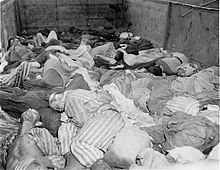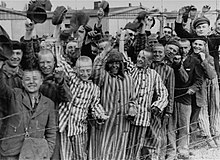Dachau concentration camp
Dachau concentration camp (German: Konzentrationslager (KZ) Dachau, IPA: [ˈdaxaʊ]) was the first concentration camp the Nazis opened during World War II. It was built in 1933 by Heinrich Himmler and was open longer than any other Nazi concentration camp.[1]



The camp was located on the grounds of an old munitions factory. It was southeast of the medieval town of Dachau, about 16 km (10 mi) northwest of Munich in the state of Bavaria, in southern Germany.[2]
The Dachau camp system grew to include nearly 100 sub-camps. These were mostly work camps (Arbeitskommandos), and were located throughout southern Germany and Austria.[3]
Between 1933 and 1945, the Nazis imprisoned over 200,000 people at Dachau and killed at least 40,000.[1]
History
changeDachau's original purpose was to hold political prisoners. Then the Nazis began using it for forced labor and to imprison German and Austrian criminals.
Nazi Germany invaded and occupied many countries during World War II. Eventually, the Nazis deported people from these countries to Dachau. It became a death camp for Jews.[4] Tens of thousands of Jews were executed there or died of starvation, disease, or overwork.[4] Nazi doctors also used Jews and other prisoners for high-altitude medical experiments, which were often fatal.[5]
The camps were liberated (freed) by the United States Army in the spring of 1945.
Deaths
changeIt is not clear how many people died at Dachau, because complete records do not exist.[6] The Nazis removed or burned their important records three weeks before the United States Army reached the camp.[7] Estimates of the number of people who died here vary widely.[8]
A few days before the Americans arrived, Germans began evacuating prisoners. But the Germans were badly organized and did not remove all of the prisoners.[7] Just before the camp was liberated 7,000 prisoners had arrived at Dachau on trains from Buchenwald concentration camp. When the liberators found the last train 2,000 of the 4,000 prisoners on it were dead.[9]
In its official report in 1945, the United States Seventh Army said that 229,000 people were imprisoned at Dachau between 1933 and 1945.[8] In 2000, Michael Perry proposed a similar number: 228,930.[10] This includes the 7,000 prisoners who arrived from Buchenwald just before the camp was liberated.[10]
References
change- ↑ 1.0 1.1 The Holocaust Encyclopedia. "Dachau". United States Holocaust Memorial Museum. Retrieved 2024-09-28.
- ↑ "Ein Konzentrationslager für politische Gefangene In der Nähe von Dachau". Münchner Neueste Nachrichten ("The Munich Latest News") (in German). The Holocaust History Project. 21 March 1933. Archived from the original on 29 November 2017. Retrieved 3 August 2015.
- ↑ Concentration Camp Dachau Entry Registers (Zugangsbuecher) 1933-1945. https://www.archives.gov/research/captured-german-records/microfilm/m1938.pdf retrieved 13 November 2014
- ↑ 4.0 4.1 "Dachau". History/A&E Television Networks, LLC. Retrieved 3 August 2015.
- ↑ "Dachau High Altitude Medical Experiments". www.jewishvirtuallibrary.org. Retrieved 2022-11-04.
- ↑ Robert L. Wise, The Bitter Road to Dachau (Nashville, TN: Broadman & Holman Publishers, 2005), p. ix
- ↑ 7.0 7.1 Dachau Liberated, ed. Michael W. Perry (Seattle, WA: Inkling Books, 2000), p. 44
- ↑ 8.0 8.1 "Dachau Death Statistics". Scrapbookpages.com. Archived from the original on 10 February 2007. Retrieved 3 August 2015.
- ↑ The End of the Holocaust, ed. Michael Robert Marrus (Westport: Meckler, 1989), p. 505
- ↑ 10.0 10.1 Dachau Liberated, ed. Michael W. Perry (Seattle, WA: Inkling Books, 2000), p. 103